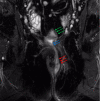Managing non-IBD fistulising disease
- PMID: 34712471
- PMCID: PMC8515280
- DOI: 10.1136/flgastro-2019-101234
Managing non-IBD fistulising disease
Keywords: anal sepsis; anorectal disorders; gastrointestinal fistulae; ileoanal pouch.
Conflict of interest statement
Competing interests: None declared.
Figures








References
-
- Sainio P. Fistula-In-Ano in a defined population. incidence and epidemiological aspects. Ann Chir Gynaecol 1984;73:219–24. - PubMed
LinkOut - more resources
Full Text Sources
